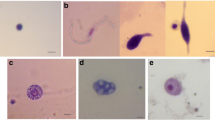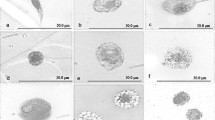Abstract
The phagostimulatory response of the larvae of the gypsy moth,Porthetria dispar, to ethanolic-aqueous extracts of the leaf powder of different host and non-host plants, was assayed in no-choice experiments using the Styropor® method.Quercus robur L. was the most active at all concentrations tested;Picea excelsa Link, was highly active only at 4%;Pyrus malus L. showed an intermediate activity at 4%; and very slight or no feeding occurred with the extracts ofPinus silvestris L.,Ilex aquifolium L. andTaxus baccata L.
The phagodeterrent effect of thePinus silvestris andIlex aquifolium extracts was demonstrated by treating the lamellae with a mixture of each one of them with the highly phagostimulatory extract ofQ. robur.
The following monoterpenes tested were highly phagodeterrent at 0.2%: α-pinene, β-pinene, 3-carene; camphene was totally deterrent even at 0.05%, whereas limonene was not phagodeterrent even at 0.2%. Among other substances coumarin and lactic acid were active at 0.2%, whereas citric acid, oxalic acid and tannic acid were not phagodeterrent even at 0.2%.
Similar content being viewed by others
References
Abbott, W.S. (1925) A method of computing the effectiveness of an insecticide.J. econ. Ent. 18: 265–267.
Ascher, K.R.S. andMeisner, J. (1973) Evaluation of a method for assay of phagostimulants withSpodoptera littoralis larvae under various conditions.Ento-mologia exp. appl. 16: 101–114.
Bennett, S.E. (1965) Tannic acid as a repellent and toxicant to alfalfa weevil larvae.J. econ. Ent. 58: 372–373.
Heddergott, H.,Menhofer, H.,Müller, F.P. andSpeyer, W. (1953) Lepidoptera, Superfamilie:Macrofrenatae. pp. 290–437.in: H. Blunck (Ed.) Handbuch der Pflanzenkrankheiten (Sorauer). Vierter Band: Tierische Schädlinge an Nutzpflanzen. Erster Teil, Fünfte neubearbeitete Auflage, Zweite Lieferung. Paul Parey, Berlin.
Heidweg, H. andThotsteinson, A.J. (1961) The influence of physical factors and host plant odour on the induction and termination of dispersal flights inSitona cylindricollis Fahr.Entomologia exp. appl. 4: 165–177.
Hsiao, T.H. andFraenkel, G. (1968) Isolation of phagostimulative substances from the host plant of the Colorado potato beetle.Ann. ent. Soc. Am. 61: 476–484.
Jermy, T., Hanson, F.E. andDethier, V.G. (1968) Induction of specific food preferences in lepidopterous larvae.Entomologia exp. appl. 11: 211–230.
Kurir, A. (1953) Die Frasspflanzen des Schwammspinners(Lymantria dispar L.). Beitrag zur Ernahrungsbiologie des Schwammspinners.Z. angew. Ent. 34: 543–586.
Matsumoto, Y. (1970) Volatile organic sulfur compounds as insect attractants with special reference to host selection, pp. 133–160.in: Control of Insect Behavior by Natural Products (Eds.D.L. Wood, R.M. Silverstein andM. Nakajima). Academic Press, New York.
Meisner, J. andAscher, K.R.S. (1972) Feeding stimulants for the larva of the Egyptian cotton leafworm,Spodoptera littoralis Boisd. II. Assaying the larval feeding response to extracts of fruits and their peels with the Styropor® method. Z.angew. Ent. 71: 337–349.
Meisner, J., Ascher, K.R.S. andFlowers, H.M. (1972) The feeding response of the larva of the Egyptian cotton leafworm,Spodoptera littoralis Boisd., to sugars and related compounds — I. Phagostimulatory and deterrent effects.Comp. Biochem. Physiol. 42A: 899–914.
Meisner, J., Ascher, K.R.S. andKamhi, J. (1970) Feeding stimulants for the larva of the Egyptian cotton leafworm,Spodoptera littoralis Boisd. I. Assaying the larval response to extracts of several host plants and to some pure substances with the Styropor® method.Wld Rev. Pest Control 9: 104–118.
Meisner, J., Ascher, K.R.S. andLavie, D. (1974) Phagostimulants for the larva of the potato tuber moth,Gnorimoschema operculella Zell.Z. angew. Ent. 77: 77–106.
Metcalf, C.L. andFlint, W.P. (1962) Destructive and Useful Insects: Their Habits and Control. 4th edn., p. 830. McGraw-Hill, New York.
ODell, T.M. andRollinson, W.D. (1966) A technique for rearing the gypsy moth,Porthetria dispar, on an artificial diet.J. econ. Ent. 59: 741–742.
Otto, D. andGeyer, W. (1970) Zur Bedeutung des Kiefernadelharzes und des Kiefernadelöles für die Entwicklung nadelfressender Insekten.Arch. Forstw. 19: 151–167.
Ritter, FJ. (1967) Feeding stimulants for the Colorado beetle.Meded. Rijksfac. Landb-Wetensch. Gent 32: 291–327.
Schoonhoven, L.M. (1972) Some aspects of host selection and feeding in phytophagous insects,in: Insect and Mite Nutrition (Ed. J.G. Rodriguez), pp. 557–566, North Holland, Amsterdam.
Smeljanez, W.P. (1969) Die Rolle der Terpenoide bei der Widerstandsfähigkeit gegen Schadinsekten.Anz. Schätdlingsk. PflSchutz. 42: 33–37.
Author information
Authors and Affiliations
Additional information
This work was done while the senior author was on a sabbatical leave from 1.XI.73-1.VI.74, at the Institut für Angewandte Zoologie, Universität München.
Rights and permissions
About this article
Cite this article
Meisner, J., Skatulla, U. Phagostimulation and phagodeterrency in the larva. Phytoparasitica 3, 19–26 (1975). https://doi.org/10.1007/BF02981217
Received:
Accepted:
Issue Date:
DOI: https://doi.org/10.1007/BF02981217




